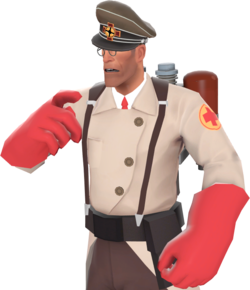Difference between revisions of "Combat Medic's Crusher Cap"
m (Added to trivia) |
m (Undo edit by PeeperSleeper (Talk) (2915926) Speculation) (Tag: Undo) |
||
| Line 39: | Line 39: | ||
== Trivia == | == Trivia == | ||
* The hat is modeled on the common panzer and infantry officer's field cap. German tankers liked the crusher variety (it can be rolled into a ball and will still unfold itself in perfect shape) because they usually wore bulky communications headgear. Hats like this have been in use since before World War I. | * The hat is modeled on the common panzer and infantry officer's field cap. German tankers liked the crusher variety (it can be rolled into a ball and will still unfold itself in perfect shape) because they usually wore bulky communications headgear. Hats like this have been in use since before World War I. | ||
| − | |||
== Gallery == | == Gallery == | ||
Revision as of 00:50, 20 December 2020
| “ | Zhey have a bomb!
Click to listen
— The Medic on occupational hazards
|
” |
The Combat Medic's Crusher Cap is a promotional cosmetic item for the Medic. It is a brown peaked cap featuring a team-colored Iron Cross, with the Team Fortress 2 logo embedded inside it.
The Combat Medic's Crusher Cap was awarded in Genuine quality to players who pre-purchased Company of Heroes 2 on Steam before June 25th, 2013.
Update history
- The Combat Medic's Crusher Cap was added to the game.
July 17, 2013 [Item schema update]
- Made the Combat Medic's Crusher Cap tradable, craftable and gift wrappable.
Unused content
- The Combat Medic's Crusher Cap is set up for paint to be applied, but the ability to do so is disabled.
Trivia
- The hat is modeled on the common panzer and infantry officer's field cap. German tankers liked the crusher variety (it can be rolled into a ball and will still unfold itself in perfect shape) because they usually wore bulky communications headgear. Hats like this have been in use since before World War I.
Gallery
See also
| ||||||||||||||||||||||||||||||||||||||||||||||||||||||||||||||||||||||||||||||||||||||||||||||||||||||||||||||||||||||||||||||||||||||||||||||||||||||||||||||||||||||||||||||||||||||||||||||||||||||||||||||||||||||||||||||||||||||||||||||||||||||||||||||||||||||||||||||||||||||||||||||||||||||||||||||||||||
| ||||||||||||||||||||||||||||||||||||||



